WHAT'S NEW ACROSS THE WORLD
Select date in side bar to go a What's
New of previous issues
| What's New ©by
Laif DeMason
The summer is finally here and with it the normal
ebb and flow in the tropical fish hobby. More than 80% of pet fish kept
throughout the world today are bred by humans and thus are not harvested
from nature. However, some species cannot be bred easily and are captured
from the wild. Often, life cycles of fishes are cued in to annual seasonal
fluctuations. Thus, the fish may only be collected during a few weeks or
months a year from their native habitats. Where fishes live in river systems,
such as many South American and West African areas, access to habitats
and capture is more easily achieved after the rains have stopped, especially
at the end of the dry season. Some cichlids in Lake Malawi and Lake Tanganyika
are also seasonal. Many open water cichlids (like Copadichromis
species) migrate inshore to breed and thus can only be caught effectively
then. So if you are looking for that special fish and it is only available
every so often, it may be seasonal. Buy them when you can; they may not
be available again for another year!
Here’s “what’s new” on the cichlid scene: |
Lake Tanganyika
Over the past several months, oversupplies of wild caught Tanganyika
cichlids have lead to some market changes. General low demand in Europe
has been more evident than ever. Local collectors and marginal exporters
from Tanganyika may thus have less than normal sales for the year. Some
of these marginal exporters will eventually close down, bringing back stable
supplies and inventories. Popular items seem to be some of the goby cichlids
and Tropheus species.
|
what's new: Lake Tanganyika
|
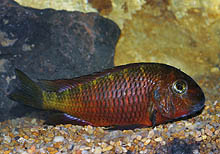
Reportedly from an area near Chimba, Zambia, Tropheus
moorii Chiwena is a new arrival with strong red hues. |
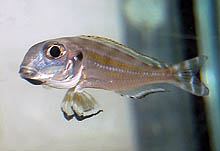
Formerly known from only preserved specimens, live
individuals of Xenotilapia caudafasciata have recently arrived in
Europe! Photo by C. Saariste-Verduijn. |
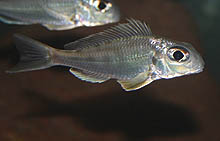
Another rarity exported from Burundi recently, Xenotilapia
longipinnis has also been available in very low numbers. Photo by T.
Andersen. |
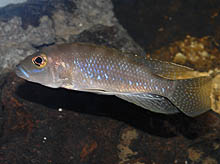
Some cichlids are still very infrequently exported
and only a few individuals at one time. With its long finnage and neon
highlights, Neolamprologus ventralis from Burundi is such a fish. |
Lake Malawi
Supplies of wild-caught and bred items are available in good numbers.
Some of the seasonal cichlids have been exported over the last two months,
such as some Lethrinops, Nyassachromis, Otopharnyx, and Copadichromis
species. Small-sized wild mbuna seem to be in demand as well as colored
haplochromines. The bright color of many Malawi cichlids has historically
been a driving factor in the interest in these fishes. It is especially
true today.
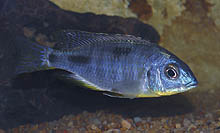
Collected seasonally around Liuli, Tanzania, Otopharnyx
decorus is a blue fish with yellow throat coloration. Territorial males
display a greenish face with vertical barring. |
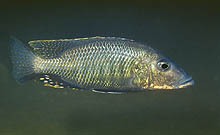
Occasionally exported from time to time, Stigmatochromis
woodii is slow to develop full coloration, but usually does so during
breeding. Photo by A. Konings. |
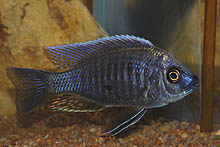
Seasonally migrating inshore near Undu Point, Copadichromis
sp. “mloto undu” sports a cream white forehead and has been imported recently.
This fish is not the same as the C. trewavasae “ivoryhead” found
elsewhere. |
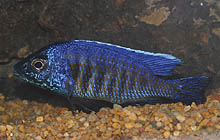
From Lundo Island, Copadichromis sp. “kawanga”
usually displays strong colors, with a striking blue head, greenish cheeks,
and orange body markings. It is also sold as C. “blueface” and is
a small-sized haplochromine. |
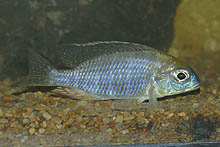
With a blue nose and a yellowish nape, Lethrinops
sp. “Mbawa” from Tanzania is likely to be L. sp. “nyassae.” This
small cichlid typically displays strong colors in the aquarium. |

Another seasonal candidate from southern Tanzania
is Copadichromis sp “azureus midnight,” a husky fish with navy blue
body coloration and a darker head. This fish is not the same as C.
sp. “mloto undu.” |
West Africa
The rainy season has begun by June in most of the West African countries
making collecting more difficult for many species. Thus the available inventory
items will be reduced compared to the previous months’ stocks. An increase
in fuel charges for air cargo items charged by airlines has also affected
prices on the species from the Kinshasa area of Congo. Many of these collected
species will be more expensive from now on.

This red-eyed Steatocranus species is an interesting
small buffalo head cichlid. It is occasionally imported from Kinshasa,
Congo along with the usual Steatocranus species. Photo by O. Lucanus. |
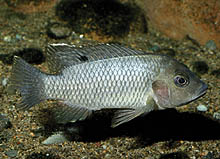
Tilapia busumana is a small species from Lake
Bosumtwi in Ghana. While quite aggressive, their small size makes them
manageable in aquarium conditions. Photo by O. Lucanus. |
Neotropics
The rainy season is ending in most South American countries and thus
fish collecting will begin again and continue through December. Many of
the hard-to-get cichlids will appear near the end of the year due to the
receding waters. In the meantime, there are still plenty of captive-bred
neotropical cichlids, both common and the exclusive. Take your pick!

Caquetaia kraussi is widespread across Venezuela
and northern Columbia, but imported infrequently. Like all Caquetaia
species, it is a large piscivore. Photo by O. Lucanus. |
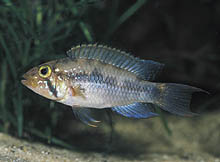
Originally from the Nanay River, Peru, this Apistogramma
martini male sports delicate blue highlights. They are one the many
species from the A. nijsseni group. Photo by U. Römer. |
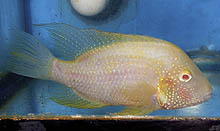
A few albino fry appeared in F1 spawns of Thorichthys
sp. “blue Mixteco,” originally from Tehuantepec in Mexico. Now the strain
breeds true, producing more albino fry. Photo by J. Rapps.
|
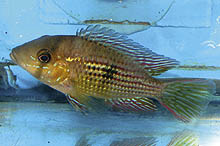
Gymnogeophagus rhabdotus collected from Convento,
Uruguay is the true G. rhabdotus with blue streaks on its soft fin
rays. It is often called G. meridionalis, which has blue spots in
the soft fin rays and comes from nearby areas. Photo by J. Rapps. |
Select date in side bar to go a What's
New of previous issues
|















